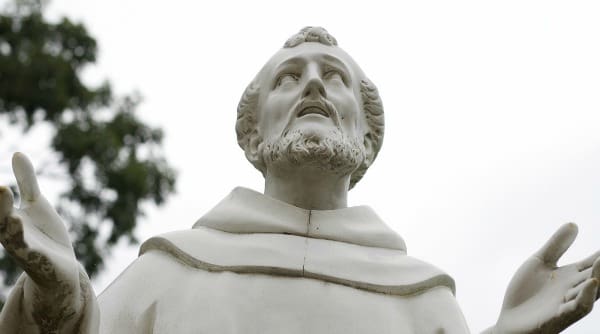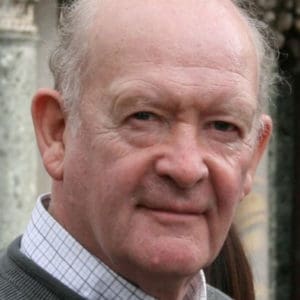Editor’s Note: David Torkington continues his series with a segue into the history of Christian Mystical Tradition, looking now at the dynamic influence of St. Francis and his order. To read part 31, see here. To begin with part 1, see here.
A Brief History of Christian Mystical Spirituality, Continued
I have already suggested that the arrival of St. Bernard should have been announced with drums rolling, cymbals clashing, trumpets sounding and spotlights highlighting him knocking on the door of the Cistercian monastery at Citeaux in 1113, for religious history was about to take one giant step forward.
But just under a hundred years later another even greater step was to take place. This time it should have been announced with Bach’s B minor Mass, Beethoven’s Missa Solemnis, and a dozen or more blasts of Handel’s Hallelujah chorus. Why? Because what was about to happen this time was not due to a quirk of history but to the direct intervention of God. This time the man in question was not a learned and brilliant young aristocrat, but a semi-illiterate draper’s son, not knocking on the door of a famous monastery but standing in a tumbledown little church called San Damiano just outside the walls of a small Umbrian town.
When something big is about to happen, and I mean really big and important, God has a habit of choosing the person we would not have thought of; someone remarkable for their lack of fitness for the task in hand, at least to the worldly-wise. It is God’s way of teaching a vital truth of the spiritual life that God’s power works best in human weakness. And it was God’s power that was about to call this otherwise insignificant little man to change the Church while simultaneously giving him the power of his love to do it.
God Speaks to St. Francis
Like St. Augustine before him, St. Francis had already experienced God in the beauty of his creation. He not only spent many months turning in prayer to the One in whom this beauty was created, but he had already undergone the beginnings of the purification that would enable God to do what came next. God spoke to him through his Son, depicted on what we have come to call the Franciscan Cross. Francis not only heard Christ speaking, but he saw his lips moving too, and he experienced this love entering into him to empower him to do what was being asked of him. The task was nothing less than to change the Church, to rebuild it from the bottom up.
After three solitary years living as a hermit for his purification to continue, he set out to do what God had commanded him to do with the first followers of his new religious order. He wanted it to be written into his rule that it was not he or anyone else for that matter who would lead this order. It was the love that Christ had sent out on the first Pentecost, the love that he received as he prayed before the Cross in the Church of San Damiano in 1205. It was this Holy Spirit who did for St Francis what he did for the first Christians—he drew him up and into the one Francis now called Friar Jesus.
The Vision of St. Francis Part 1
It was therefore now through mystical experience rather than through intellectual reasoning that Francis came to see and understand the sublime mystical vision that is at the heart of authentic Franciscan Spirituality. The one St. Francis called Friar Jesus, who humbled and emptied himself of his supernatural birthright and entered into him, was the very Word of God who had reigned with him from eternity, in whom everyone and everything had been created from the beginning. This led St. Francis to realize that if everyone and everything had been created in Friar Jesus then all the world must be a friary.
The Greek philosopher Plato said that the world was a prison. Shakespeare said that all the world was a stage and the men and women merely players, and a President of the United States said that all the world was a market place and the men and women merely buyers and sellers.
But for Francis of Assisi, all the world was a friary, and everyone and everything within it were, therefore, brothers and sisters to one another. It is not just Brother Francis and Sister Clare then, but Brother Sun and Sister Moon, Brother Wolf and Sister Lamb, Brother Fire and Sister Water, for the whole of creation is a brotherhood and sisterhood with a common Father in whose embrace all were created from the beginning. That is why conservationists see in St. Francis their inspiration and that is why he was declared their patron from the outset.
The Vision of St. Francis Part 2
However, this is not the end of the vision of St. Francis, but the beginning, the place of departure. For the Masterwork of Creation is Brother Jesus in whom all things were not only created, but in whom they all subsist now, and through whom all things will return to the place where they were first conceived, as to their ultimate destiny. What he saw so clearly was that by coming to know and love Brother Jesus, he could enter into him and with him come to know and love the Father, to taste even in this life something of the bliss to which we have all been called in the next life.
Knowing and believing is one thing, taking the next step and dedicating your whole life to pursuing this vision is quite another. This is what St. Francis did every day of his life. If you love someone and want to love them more to experience their love in return, you simply must give them your time. This is what Francis did possibly more regularly and for ever greater lengths of time than any before or after him.
St. Francis and Personal Prayer
Every Lent, Francis spent forty days in solitude and further weeks or months leading up to major feasts like Christmas. He redesigned the structure of his daily life so that both he and his brothers could have the maximum time possible for the prayer and meditation that leads to contemplation. He radically shortened the long monastic Office which could last as long as eight hours and replaced it with a much shorter one. He did not do this because he thought the Office that he loved was unimportant, but because he considered that the contemplation which he wanted all his friars to embrace to be even more important.
His friars were called to an apostolate in the world and, as well as everything else, this meant many hours of traveling in those days. That is why he wanted his brothers to learn how to come through meditation on Christ to generate the love that would lead them into contemplation as soon as possible. The reason was simple; it is not easy to travel or work in the world whilst saying or reciting the Divine Office or while practicing Lectio Divina or some other method of meditation, but contemplation is quite a different matter. It is by its very nature extremely simple if at times extremely difficult, nor do you need others alongside you to practice it. You do not need anything other than a burning yearning for God and the simplest of prayers to keep fixed on God.
Francis and Contemplation
Strange though it may sound, it is contemplation that is the perfect prayer for those working for God in the world. The original hope was that a young person’s fervor should be so encouraged that even before the novitiate was over they could be led into the beginnings of contemplation, and by the time their training was completed it would be their prayer of choice for life. This at least was the ideal, and in those days there were many spiritual directors to guide the young.
It was to maintain this ideal that hermitages were set up in solitary places for the friars to go for prolonged periods of time as St. Francis did. As well, a revised timetable for prayer gave far less time for communal liturgical prayer to maximize time for personal contemplative prayer that St Thomas Aquinas said embodied the very essence of the new contemplative orders. The early sources show how night after night the friars would pray after the midnight office until dawn. The other mendicant orders like the Dominicans and the Carmelites would eventually also use the new shorter office, called the Roman Office, and make more time for personal prayer to contemplation, each according to their own particular charism.
To Share the Fruits of Contemplation with others
St. Augustine, St. Gregory the Great and St. Bernard all agreed that although the love experienced in contemplation could not be described, something else could. This was the truth that became clearer to the contemplative the further he or she traveled on the mystic way enabling the receiver to see with such clarity and ever-deepening detail what they thought they had known before. Seen from the outside, a stained glass window of the Risen Christ contains all the detail that can be seen within, but when the sun shines through it, it becomes alive and totally engages the viewers and filling them with joy. This is why St. Thomas Aquinas defined contemplation as ‘a simple vision of the truth accompanied by awe’. The further contemplation deepens, the more the contemplative sees God’s incredible plan for the world and the part he wants us to play in its implementation. That is why St. Thomas insisted that the very raison d’etre of mendicants was to share the fruits of contemplation with others.
Now perhaps it can be seen how St. Francis was able to see, not just with such clarity, but in poetry and in technicolor what St. Paul originally called ‘God’s Secret Plan’, and to see the way to enter into it by entering through Love into the one who embodied it in his mystical body. I have detailed the mendicant way of prayer as practiced by St. Francis because his way is not just for religious but for all. We are all called to contemplation and to share the fruits of contemplation with others, as did the first Christians, who through contemplation came to practice the prayer without ceasing that generated the supernatural love that took the ancient pagan world by storm. Each of us, in our own way, has to find time for having time with the One who continually loves us. The last section of this series is written for those who are prepared to do this.
Image by jdcovell from Pixabay.




